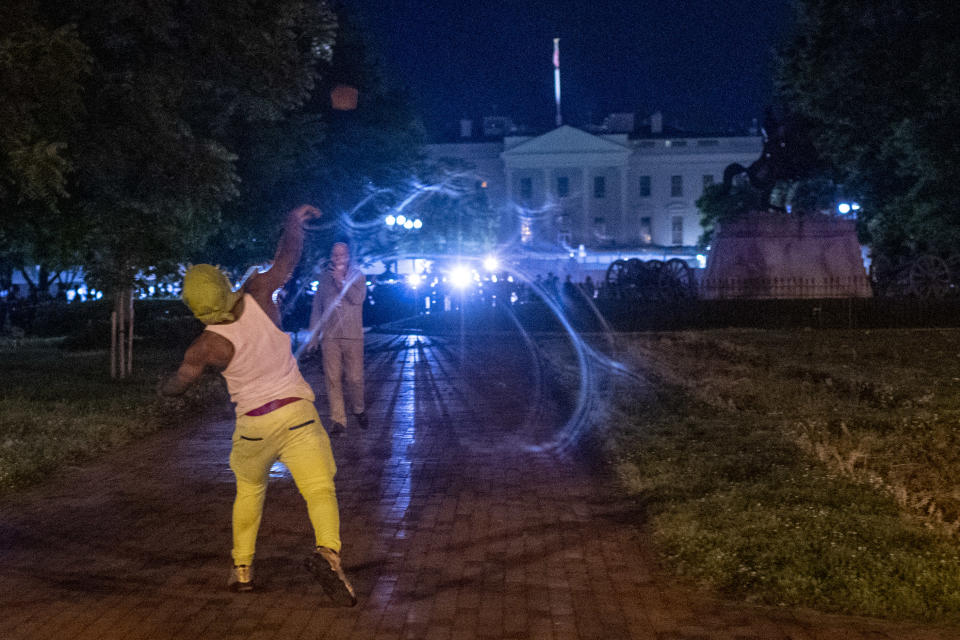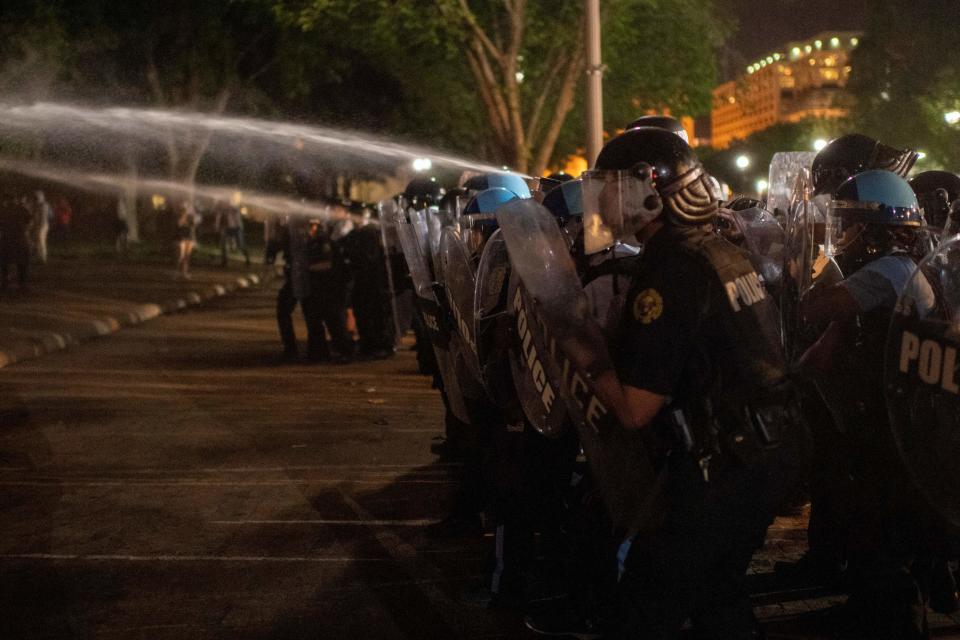Night of rage on Pennsylvania Avenue as protesters clash with Secret Service in front of the White House
WASHINGTON — The barricades in front of the White House were breached in the wee hours of Saturday morning as the wave of protests that has swept the nation following the death of George Floyd quite literally hit President Trump’s doorstep.
The demonstrations led to dramatic clashes involving fists, shields and tear gas against the backdrop of Trump’s official residence. Hundreds of protesters marched through the nation’s capital and made their way to Pennsylvania Avenue early Saturday morning where they engaged in hours of violent clashes with Secret Service officers before being dispersed with pepper spray.
Trump addressed the protests outside his home in a series of tweets on Saturday.
“Great job last night at the White House by the U.S. @SecretService. They were not only totally professional, but very cool. I was inside, watched every move, and couldn’t have felt more safe,” Trump wrote.
Hundreds of protesters moved through Washington, D.C., on Friday evening as part of the nationwide backlash against the killing of George Floyd, who died after being taken into police custody in Minneapolis. Footage showed Floyd saying that he could not breathe as Minneapolis police officer Derek Chauvin allegedly held his knee on Floyd’s neck.

Chauvin was subsequently fired and charged with third-degree murder, but the incident has sparked several nights of nationwide protests, which came on the heels of other videos of black men being killed by police and would-be vigilantes.
Trump told Yahoo News earlier on Friday that he supported many of those who protested Floyd’s killing in Minneapolis.
“Certainly there were a lot of different people and there were good people too and they were protesting,” Trump said at the White House. “They were protesting for the right reason. They were protesting in honor of a man, George Floyd, where something happened that should not have happened.”
But Trump had also tweeted Friday that “when the looting starts, the shooting starts,” which was widely seen as a threat to protesters. Trump later appeared to walk back the tweet, saying it was a “fact, not a statement.”
Protesters removed multiple steel fences that stood across from Trump’s residence as the demonstrations crept late into the evening. In total, the demonstrators removed more than 15 barricades that they had piled up on the ground in a park across the street from the White House.
The demonstrators squared off with uniformed Secret Service officers who kept them at bay with riot gear and shields. Around 2 a.m., hours after the protests in D.C. had begun, officers from the U.S. Park Police arrived to reinforce the Secret Service. The combined forces of officers who lined up in front of the White House were subjected to insults from the crowd.
“I see you for what you are: a racist murderer,” one protester yelled at police. “You are scared of me. … You have to hide behind a badge.”
The protester added he was at the demonstration because he was “tired of the police killing my people for no reason simply for being black.”
Many of the insults were directed at the Secret Service officers of color. One man named Eddie said he was frustrated with the more diverse elements of the officer corps because “they’re standing there not saying anything.”
“At the end of the day we’re all human. … No matter your color, at the end of the day we’re all human,” said Eddie, who declined to give his last name.
Eddie, who wore a button-down shirt and a mask, said he believed Floyd had been murdered and that he was protesting to honor his memory.
“They killed him, so we ... speak for Mr. Floyd,” Eddie said.
Protesters hurled plastic bottles and bricks at the Secret Service. Agents, in turn, charged the protesters with plastic riot shields. Multiple protesters said they were concerned about both potential violence stemming from the confrontation with police as well as the possibility of being exposed to the coronavirus.
“This seems exponentially more important than not getting sick,” a female protester said as she stood within the group crowded in front of the White House.
Yahoo News asked an African-American Secret Service officer if he believed the situation could be deescalated.
“Doubtful it could happen,” the officer, who was also talking to protesters, said. “You kill somebody — how you deescalate that? He ain’t coming back, right? At this point, what you going to do?”
Some protesters said they appreciated the officer’s apparent concern for Floyd.
“At least we’re talking now,” one of the demonstrators said.
“I take this off, I’m still black,” said the officer, gesturing toward his uniform.

As the protests continued, demonstrators and Secret Service officers battled in Lafayette Park, which sits across from the White House. Protesters managed to wangle multiple shields and barricades from the officers.
Even after the reinforcements from the Park Police appeared on the scene, protesters managed to take down more barricades and seize multiple riot shields from officers.
The Secret Service on Saturday did not respond to questions about the protests, including some about which agencies were involved in responding. The Park Police also did not respond to questions.
In his tweets about the protests, Trump suggested that Washington, D.C., Mayor Muriel Bowser prevented her city’s police force from responding to the protests.
“On the bad side, the D.C. Mayor, @MurielBowser, who is always looking for money & help, wouldn’t let the D.C. Police get involved,” Trump wrote.
In response, D.C. police pointed to comments Bowser made in a press conference on Saturday afternoon.
“I want to be very clear: My police department in Washington, D.C., will always protect D.C. and all who live and visit here. In fact, that is exactly what we did yesterday and last night. No one needed to ask the Metropolitan Police Department to get involved because we were already involved,” Bowser said.
She added: “D.C. police supported [the] uniformed Secret Service last night like we have done literally dozens of times at Lafayette Park. [D.C. police], the U.S. Park Police and the Secret Service coordinated throughout the evening and night, and at no time was the chief of police concerned about losing control of protest activity in Washington, D.C.”
The Secret Service and Park Police swept into and dispersed the crowd using pepper spray at 3:22 a.m. on Saturday. Officers from both agencies also pushed credentialed press out of the park across from the White House.
“Get the f*** out of the park!” officers said.
_____
Click here for the latest coronavirus news and updates. According to experts, people over 60 and those who are immunocompromised continue to be the most at risk. If you have questions, please refer to the CDC’s and WHO’s resource guides.
Read more:


